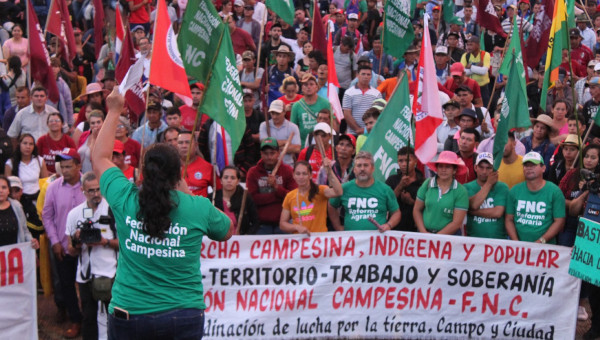Bolivia: When Fantasy Trumps Reality
Under the presidency of Evo Morales, Bolivia has achieved a new constitution incorporating the rights of indigenous peoples, the beginning of land reform, the nationalization of important natural resources and increased state social spending to the poor. We hear nothing of this in the mainstream media. And ironically, although the left is fiercely critical of biased media coverage, it can also fall in the trap of media distortion, particularly if its coverage dovetails with its own fantasies.

This position fits nicely with the outlook of Socialist Alternative, which also condemns Bolivia’s first indigenous president. Lopez wrote that Morales’ moves “against the working class” have led to “the first large-scale action of workers in opposition to the Morales government.”
According to Lopez, “demonstrations were held around the country [on May 4], accompanied by a 24-hour general strike which was then extended indefinitely.” Despite the “sellout” of the Bolivian Workers’ Federation (COB) leadership, Lopez assured us “the strike is well into its second week.” A deal struck between Morales and the COB has been “resolutely rejected,” Lopez said, and “the strike continues.”
The ‘Indefinite General Strike’ that Wasn’t
On May 1, as well as nationalizing four electricity companies, Morales restated his government would not increase workers’ salaries by more than 5%. This was met with protests in various cities. COB general secretary Pedro Montes announced a follow-up 24-hour strike for May 4.
Reporting on the May 4 “general strike,” Bolpress said, “hundreds of teachers, factory workers and health workers …. alternated down the Prado in La Paz” in divided marches. La Prensa said “at least 500” factory workers descended on the labour ministry, where they attempted to burn down the front door, leading to 15 arrests.
Pedro Alberto Calderon, a leader of the La Paz factory workers, continued the dispute with the miners by calling for Montes’s expulsion from the COB “because he has betrayed the whole working class” by not marching in La Paz, La Prensa said. Montes instead chose to join a miners’ march in Oruro.
News sources also reported 500 health workers marched in Santa Cruz. In Cochabamba, factory workers blocked the local bus terminal. About 500 to 1,000 marched in Sucre, and smaller protests were held in the other capital cities.
“In the combative city of El Alto,” Bolpress said, “productive activity was normal,” as in most of Bolivia.
On May 7, a COB assembly called for an “indefinite general strike” to begin May 10, La Razon said.
In response, Bolivia’s largest peasant organization, the United Confederation of Bolivian Peasant Workers (CSUTCB), the national women’s peasant federation, the coca growers’ union from the Chapare, and the Departmental Workers Centre of Santa Cruz all defended the government and opposed against COB’s actions, because “they only hurt the brothers and sisters of the countryside and the country” (Bolpress, May 10).
The CSUTCB is the largest COB affiliate, representing 1.5 million peasants. It is a key part of Morales’s Movement Toward Socialism (MAS) party.
By May 11, everyone agreed the “indefinite general strike” was a flop. La Razon’s website that day read: “Support scarce for general strike.”
Union leaders representing teachers, health workers and factory workers did not strike, but were negotiating with the government, La Razon said. In an article headlined “The government’s offers weaken COB protests,” Bolpress said union divisions “weakened to the point of converting the general strike to almost nil.”
Instead, La Prensa said, 300 workers, mainly miners, gathered in Caracollo to begin a 200-kilometer walk to La Paz.
Tentative Agreement
The night before, the COB and the government reached a tentative agreement to lower the retirement age from 65 to 58 (51 for miners). Bosses would also be forced to contribute to workers’ pension funds.
The COB, affiliated unions and government officials began to discuss the new proposals. Although the COB agreed to the new proposals, Bolpress said, some teachers, health workers and factory workers rejected it.
La Razon said after further discussions, the health workers’ union also agreed to the government proposals and called off future actions.
ABI reported on May 13 that Guido Midma, the executive secretary of the miners’ federation who was approvingly quoted in Lopez’s article, said: “The miners’ federation will not allow others to attack [the COB]. On the contrary, we call on these sectors to reflect, because they are automatically marginalizing themselves.”
A small contingent, mostly teachers, continued the march to La Paz. Factory workers and teachers pledged to once again “radicalize” their protests on May 18. They also continued to call for Montes’ removal and the sacking of several government ministers.
By May 17, La Prensa said, the La Paz factory workers’ union had decided to postpone their actions. Union leader Wilson Mamani said the decision was taken at the request of other factory workers around the country.
On May 18, media reports said between 3,000 and 15,000 teachers arrived in La Paz, culminating the march from Caracollo. The National Confederation of Urban Teachers, however, was no longer supporting the march, although it continued to oppose the government’s position.
Teachers’ union leader Federico Pinaya told La Razon some sectors of the union were trying to use the protests in the lead-up to internal union elections. Rural teachers’ unions pulled out of the protests and returned to the negotiating table.
By May 21, the only sector still protesting was a militantly anti-Morales section of the urban teachers union, who were demanding their wages be brought to the level of rural teachers. But even the leaders of the teachers’ union have since come to an agreement with the government, subject to approval from the membership.
Bolivian Reality
The small scale of the strikes and protests does not mean the government’s proposed pay rise should not be debated or challenged.
There are tensions between the Morales government and its base. In the April 4 national elections, MAS faced more competition from dissident MAS sectors than right-wing forces. The Morales government has also had to face a range of small, but significant, conflicts with sectors traditionally aligned with MAS.
It is clear the movement for change in Bolivia needs to reflect on some of these warning signs.
However, confusing an “indefinite general strike” with a lot of huffing and puffing by a few union leaders, and symbolic protests, mixed with a good dose of internal union politicking, only leads us away from the real issues.
Today, the Bolivian workers’ movement is far from the powerful force some Bolivian union leaders and foreign leftist like to fantasy it still is.
Bolivia’s organized workers’ movement is still suffering from the defeats inflicted by the implementation of neoliberal policies.
About 62% of the working class is in the informal sector, 83% in small companies with less than 10 workers, and the unionization rate is only 23%. This rate has steadily increased under the Morales government.
Nor is this the same Bolivia as in the past. A 1970 COB thesis Lopez quoted approvingly does not mention the word “indigenous” once, even though the long-oppressed indigenous peoples make up about two-thirds of the population.
If this policy of refusing to acknowledge indigenous peoples’ existence was mistaken then, it is criminal today.
Today, a revolutionary movement has developed, whose future is still to be determined – even if it didn’t occur according to COB theses or manuals from afar.
With the COB in steady decline, it was indigenous and peasant sectors that led the resistance to the military dictatorship in 1978, and constructed the CSUTCB as its own independent organization in 1979. These sectors led the process of recapturing the historically marginalized indigenous peoples’ self-identity and pride.
The resistance to neoliberalism over 1990-2005 did not emerge from the factories. It began in the countryside and spread to indigenous workers and the urban poor. The main indigenous and peasant organizations decided it was necessary to move from resistance to taking power. In the 1990s, they decided at a congress of Bolivia’s most powerful unions to build their own political instrument to this end – creating what is now the MAS.
Indigenous Struggles
As a result of this historic decision and the mass struggles that followed, they put one of their own in the presidency in 2005, electing Morales with a record high of 54% of the vote.
A new constitution incorporating the rights of indigenous peoples, the start of land reform, the nationalization of important natural resources and increased state social spending to the poor are some of the gains won since.
Lopez’s article mentions none of this.
Morales also plays a leading role internationally in attacking the capitalist system for its responsibility for the climate crisis. Morales hosted a “people’s summit” in Cochabamba in April that brought together 35,000 people from around the world to organize to fight back.
This does not mean the government cannot be criticized or that workers should not fight for their demands.
But to paint the Morales government as the main enemy because of a dispute over wages, while failing to mention even once the suffering and resistance of the most marginalized who have benefited most from the Morales government, is blind sectarianism.
To raise the wage demands of a sector of workers as the central issue in Bolivian politics, while ignoring the broader changes under way and the challenge any revolutionary government would face in lifting South America’s poorest nation out of poverty and dependency, is pure and simple economism – that is, counter-posing demands about wages to the broader struggles of the oppressed.
Such positions are rejected by Bolivia’s indigenous majority because they understand that, for the first time, they are charting their own path toward liberation.
Bolivia’s revolutionary process needs a strong independent working class to help push it forward. But this goal is not advanced by denouncing as “sell-outs” anyone who tries to relate to Bolivian reality. •





